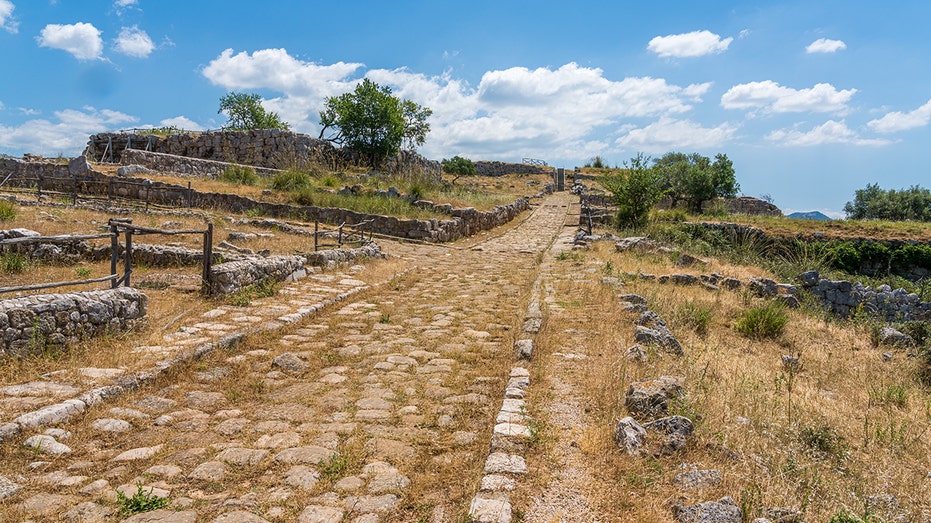Science
Archaeologists Map Expanded 300,000 km Roman Road Network

A new digital atlas has unveiled a vast network of Roman roads that stretches approximately 300,000 kilometers (186,000 miles), a significant increase of over 100,000 kilometers from previous estimates. This groundbreaking finding, published in the study titled Itiner-e, emerged following the discovery of Roman cavalry swords by an amateur metal detectorist in Gloucestershire, leading archaeologists to unearth a 2,000-year-old settlement that includes a villa and other structures.
The previous comprehensive atlas was released 25 years ago and relied on incomplete records, limiting the understanding of the Roman road network. The new study combines historical documents, aerial imagery, and advanced digital mapping techniques to provide a clearer picture of these ancient pathways. Researchers utilized satellite tools and historical records, including data from World War II, to identify routes that once connected settlements across Europe, North Africa, and the Middle East.
Innovative Techniques Enhance Historical Understanding
Over five years, a dedicated team of archaeologists meticulously analyzed ancient journals, locations of Roman milestones, and various archival sources. By examining aerial photographs for subtle signs, such as changes in vegetation or soil, the researchers could identify where Roman roads may have existed. Tom Brughmans, an archaeologist and co-author of the study published in Scientific Data, characterized the process as a “massive game of connecting the dots on a continental scale.”
The atlas not only maps primary roads but also reveals a network of secondary routes that linked villas, farms, and military outposts. This extensive mapping provides insights into how the movement of people during Roman times influenced historical trends, including the spread of Christianity and ancient epidemics. The detailed routes span from Spain to Syria, connecting more than 5,000 ancient settlements.
Researchers previously estimated the length of Roman roads at around 188,000 kilometers (117,000 miles), primarily focusing on major highways within the empire. The new findings identify additional roads that had previously gone undocumented, particularly in regions such as North Africa, the interior plains of France, and the Peloponnese peninsula of Greece. According to Benjamin Ducke of the German Archaeological Institute, who was not involved in the project, this atlas will serve as a foundational resource for future research.
Significance of the Findings
The title Itiner-e pays homage to ancient Roman itineraria, travel registers that detailed road stations and distances between towns. The methodology combines historical documentation with advanced Geographic Information Systems (GIS), LiDAR technology, and crowdsourced archaeological data.
The study noted that only about 2% to 3% of the mapped routes have “high certainty,” meaning clear physical traces remain. The remainder is classified as probable or inferred, supported by various historical or environmental indicators. The visualization of these routes offers a valuable tool for historians examining military logistics, trade networks, and cultural exchanges that occurred during the Roman Empire.
The wide-ranging impact of the Roman road network is evident, as it laid the groundwork for many modern routes still in use today. According to co-author Adam Pažout from the Autonomous University of Barcelona, “The Romans left a huge impact with this road network.”
The interactive map and dataset from the study are publicly accessible at itiner-e.org, allowing scholars, educators, and the public to explore these ancient roads and their historical significance in detail. The findings not only enrich academic understanding but also cater to the interests of travelers and history enthusiasts alike, highlighting the enduring legacy of Roman civilization.
-

 World3 weeks ago
World3 weeks agoGlobal Air Forces Ranked by Annual Defense Budgets in 2025
-

 World4 weeks ago
World4 weeks agoMass Production of F-35 Fighter Jet Drives Down Costs
-

 Science4 weeks ago
Science4 weeks agoTime Crystals Revolutionize Quantum Computing Potential
-

 World3 weeks ago
World3 weeks agoElectrification Challenges Demand Advanced Multiphysics Modeling
-

 Top Stories3 weeks ago
Top Stories3 weeks agoNew ‘Star Trek: Voyager’ Game Demo Released, Players Test Limits
-

 Business4 weeks ago
Business4 weeks agoGold Investment Surge: Top Mutual Funds and ETF Alternatives
-

 Top Stories3 weeks ago
Top Stories3 weeks agoDirecTV to Launch AI-Driven Ads with User Likenesses in 2026
-

 Lifestyle3 weeks ago
Lifestyle3 weeks agoDiscover Reese Witherspoon’s Chic Dining Room Style for Under $25
-

 Entertainment3 weeks ago
Entertainment3 weeks agoFreeport Art Gallery Transforms Waste into Creative Masterpieces
-

 Health3 weeks ago
Health3 weeks agoGavin Newsom Critiques Trump’s Health and National Guard Plans
-

 Business3 weeks ago
Business3 weeks agoUS Government Denies Coal Lease Bid, Impacting Industry Revival Efforts
-

 Lifestyle3 weeks ago
Lifestyle3 weeks agoLia Thomas Honored with ‘Voice of Inspiration’ Award at Dodgers Event









